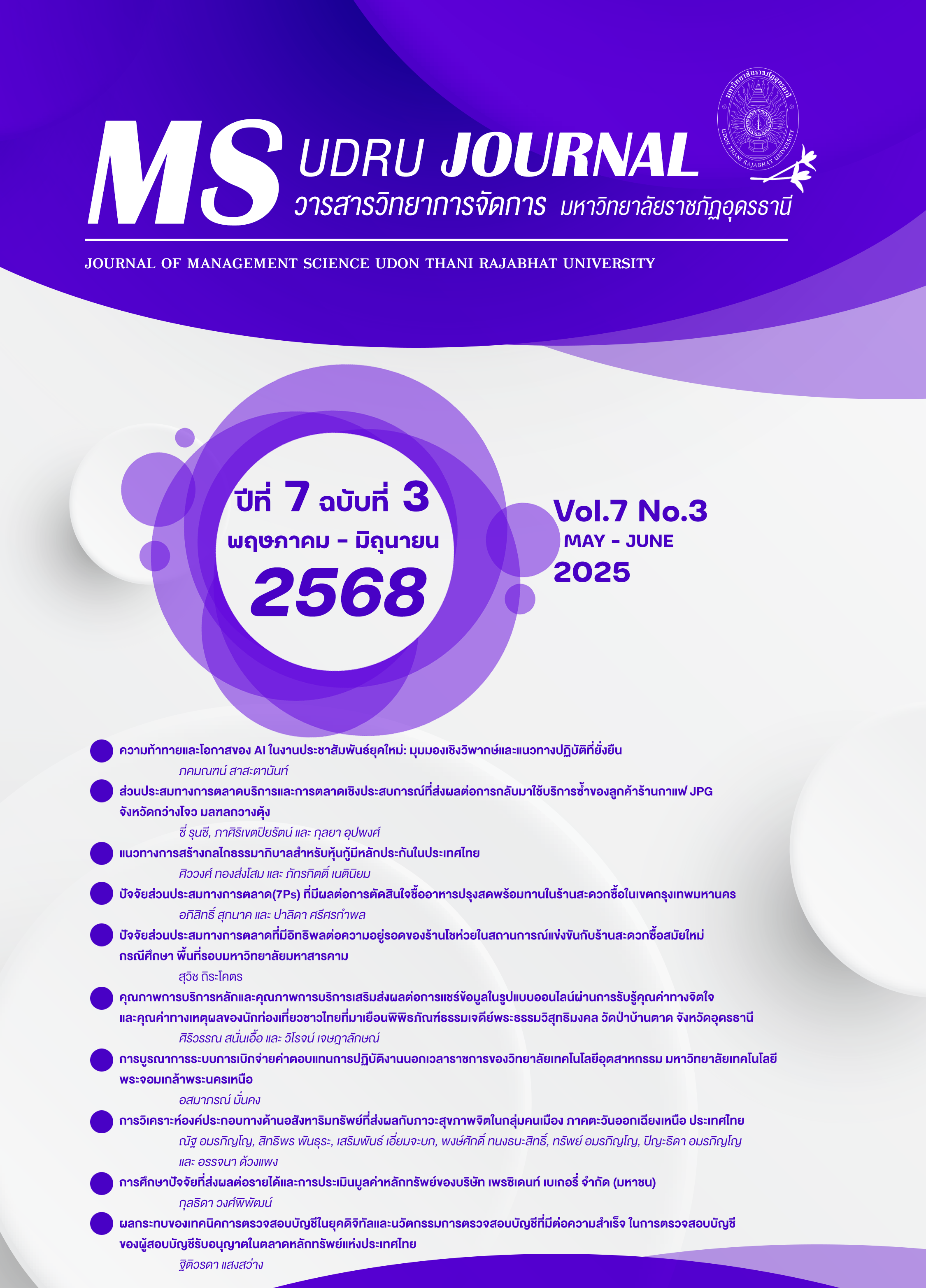A STUDY OF REAL ESTATE COMPONENTS INFLUENCING MENTAL HEALTH CONDITIONS IN URBAN COMMUNITIES OF NORTHEAST THAILAND
Main Article Content
Abstract
This study analyzes the impact of real estate factors on the mental health of urban populations in Udon Thani, a province experiencing rapid urbanization. Urban expansion often brings significant changes in infrastructure, real estate development, and environmental conditions, which in turn influence mental well-being. This research aims to identify the key real estate-related determinants affecting urban mental health and to provide insights for sustainable urban planning.
A mixed-methods approach was employed, integrating qualitative and quantitative research methodologies. Data collection involved primary surveys, expert interviews, and statistical analysis of real estate conditions and mental health indicators. Factor analysis (EFA) was conducted on data from 400 respondents to explore the relationships between urban real estate environments and mental health outcomes. Four primary factors were identified: (1) accessibility and quality of mental health services, (2) community integration and social environment, (3) availability of open and green spaces, and (4) residential quality and environmental stressors.
The findings highlight the crucial role of urban planning in fostering environments that support mental well-being. Recommendations include enhancing access to mental health services, improving urban design for community interaction, expanding green spaces, and ensuring high-quality residential infrastructure. The study provides a foundation for policymakers, urban planners, and researchers to develop strategies for creating sustainable and mentally supportive urban environments in rapidly growing cities.
Article Details

This work is licensed under a Creative Commons Attribution-NonCommercial-NoDerivatives 4.0 International License.
บทความที่ได้รับการตีพิมพ์เป็นลิขสิทธิ์ของคณะวิทยาการจัดการ มหาวิทยาลัยราชภัฏอุดรธานี
ข้อความที่ปรากฏในบทความแต่ละเรื่องในวารสารวิชาการเล่มนี้ ไม่ใช่ความคิดเห็นและความรับผิดชอบของผู้จัดทำ บรรณาธิการ กองบรรณาธิการ และคณะวิทยาการจัดการ มหาวิทยาลัยราชภัฏอุดรธานี ความรับผิดชอบด้านเนื้อหาและการตรวจร่างบทความแต่ละเรื่องเป็นความคิดเห็นของผู้เขียนบทความแต่ละท่าน
References
Adger, W. N. (2003). Social capital, collective action, and adaptation to climate change. Economic Geography, 79(4), 387–404.
Andersen, R. M. (1995). Revisiting the behavioral model and access to medical care: Does it matter? Journal of Health and Social Behavior, 36(1), 1–10.
Andersen, R. M. (2008). National health surveys and the behavioral model of health services use. Medical Care, 46(7), 647–653.
Babitsch, B., Gohl, D., & von Lengerke, T. (2012). Re-revisiting Andersen’s Behavioral Model of Health Services Use: A systematic review of studies from 1998–2011. GMS Psycho-Social-Medicine, 9.
Costanza, R., et al. (2017). Changes in the global value of ecosystem services. Global Environmental Change, 26, 152–158.
Evans, G. W., & Kantrowitz, E. (2002). Socioeconomic status and health: The potential role of environmental risk exposure. Annual Review of Public Health, 23(1), 303–331.
Evans, G. W., Wells, N. M., & Moch, A. (2003). Housing and mental health: A review of the evidence and a methodological and conceptual critique. Journal of Social Issues, 59(3), 475–500.
Folke, C., et al. (2005). Adaptive governance of social-ecological systems. Annual Review of Environment and Resources, 30, 441–473.
Giddens, A. (1990). The consequences of modernity. Stanford University Press.
Gifford, R. (2007). The consequences of living in high-rise buildings. Architectural Science Review, 50(1), 2–17.
Harvey, D. (2006). Spaces of global capitalism: Towards a theory of uneven geographical development. Verso.
Kawachi, I., & Berkman, L. F. (2001). Social ties and mental health. Journal of Urban Health, 78(3), 458–467.
Levesque, J. F., Harris, M. F., & Russell, G. (2013). Patient-centred access to health care: Conceptualising access at the interface of health systems and populations. International Journal for Equity in Health, 12(1), 18.
Maas, J., Verheij, R. A., Groenewegen, P. P., De Vries, S., & Spreeuwenberg, P. (2006). Green space, urbanity, and health: How strong is the relation? Journal of Epidemiology & Community Health, 60(7), 587–592.
Marcuse, P. (2009). Social sustainability: Towards some definitions. Haworth Press.
Nuru-Jeter, A., & Williams, C. T. (2006). Examining the importance of housing as a social determinant of health. Journal of Urban Health, 83(3), 406–412.
Penchansky, R., & Thomas, J. W. (1981). The concept of access: Definition and relationship to consumer satisfaction. Medical Care, 19(2), 127–140.
Pickett, K. E., & Pearl, M. (2001). Multilevel analyses of neighbourhood socioeconomic context and health outcomes: A critical review. Journal of Epidemiology & Community Health, 55(2), 111–122.
Pretty, J. (2003). Social capital and the collective management of resources. Science, 302(5652), 1912–1914.
Putnam, R. D. (2000). Bowling alone: The collapse and revival of American community. Simon & Schuster.
Saegert, S. C., & Winkel, G. H. (2004). Environmental psychology. The International Encyclopedia of the Social & Behavioral Sciences, 5, 4423–4429.
Smith, N. (1984). Uneven development: Nature, capital, and the production of space. Blackwell.
Ulrich, R. S., Simons, R. F., Losito, B. D., Fiorito, E., Miles, M. A., & Zelson, M. (1991). Stress recovery during exposure to natural and urban environments. Journal of Environmental Psychology, 11(3), 201–230.
Walker, B., et al. (2004). Resilience, adaptability and transformability in social–ecological systems. Ecology and Society, 9(2), 5.
Wilkinson, R. G., & Marmot, M. (2003). Social determinants of health: The solid facts. World Health Organization.


